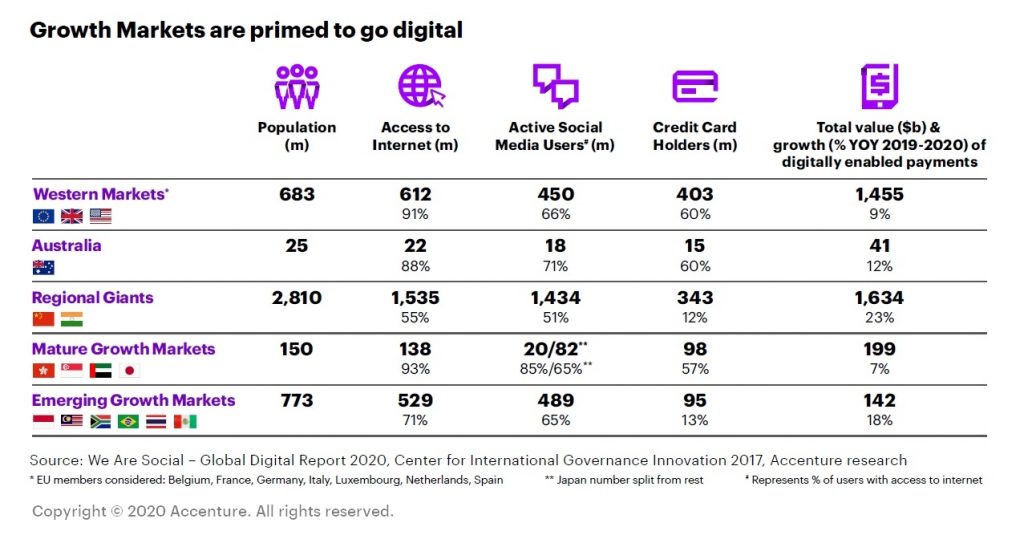Other parts of this series:
- Digitally Mature Banks: Why the Future’s in Their Hands
- COVID-19 Resilience, Digital Maturity and Outperformance
- Digital Maturity + COVID-19 Resilience = Strategy
- Digitise for Efficiency and Agility
- A future-ready approach: Building “Living Systems” for banks
- Restructure to Survive: How to turn around the weakest banks
- A future-ready approach: Journey to the cloud
- Banking’s cloud imperative: Succeeding in an altered landscape
The COVID-19 pandemic has upended the global economy and forced the financial services industry – along with nearly every other sector – to accelerate its journey along the road to digitalisation. In this series of blogs, I’ll map out the future of banking in Growth Markets in a post-COVID-19 world, and show you the factors I believe will separate the winners from the also-rans.
Readers of Accenture’s banking blogs will know that my colleagues have written extensively and informatively about the impact COVID-19 has had on banking: how the shift to digital has accelerated the downward trend in branch banking, for example; how it will affect global payments in the long-term; and how this moment represents an ideal time for banks to get back to basics by helping clients manage their finances better.
The impact of this pandemic extends well beyond those areas. Most notably, it has intensified the need for banks to speed up digital adoption. As my colleague Alan McIntyre has written elsewhere, COVID-19 has sharpened minds at the highest levels about the benefits of digitisation. Some executives now regret they’d been so slow-moving with enacting transformation when they had the time and resources to do so.
It’s self-evident that banking’s future is digital. But it’s worth reiterating the four factors that are driving this:
- The first is shifting competition, with digital challenger banks and other new entrants reshaping the sector;
- The second is the evolution of an environment of digital-first customer journeys underpinned by data;
- The third is industry convergence, with digital challengers and open banking reinventing the sector to meet customers’ heightened expectations;
- And finally, there is the rise of emerging technologies, from distributed ledger technology (DLT) to artificial intelligence, and from extended reality to quantum computing – among the trends we collectively call DARQ Power.
Accenture’s Digital Maturity Index
Leading banks are already pursuing their digital future – and it’s paying off. When Accenture researched the biggest banks operating in 21 key global markets – from the US to China to Japan to Australia – we found a clear correlation between banks’ digital maturity and their financial and market performance.
We ranked these banks on our Digital Maturity Index. This measures digital usage for sales and services, customer satisfaction with digital offerings, the bank’s digital intent (whether it’s set up a digital bank, for instance, or has announced digital transformation plans), and its level of investment in fintechs and digital technologies. (If you’re interested to assess how your bank might fare, I recommend “Are you really a digital bank? Ten key questions to assess digital maturity”.)
Just 13 percent of banks scored the top ranking of highly digitally mature. These banks outperformed their lower-ranked peers in every metric – and in most cases by significant margins (see chart).

What are they doing right? That goes back to data, one of the factors driving banking’s digital future. Not only do digitally mature banks use data to boost financial services (FS) revenues and non-FS revenues; they are also providing value-added digital services within their own boundaries and in partnership with GAFA firms and fintechs as they move towards invisible banking.
Equally importantly, all of these services generate relevance for their customers. As Brett King – “The Godfather of Fintech” and host of the world’s top-rated fintech podcast – put it recently, that’s where the future of banking lies: “Embedding banking services in applications to meet people where they are and at the exact moment they need service … a seamless approach that reduces friction.”1
When it comes to traditional FS revenues, leading banks generate revenues from customer acquisitions, cross-selling and up-selling, and – outside their boundaries – partnering to earn from payments services. Non-FS revenues come internally from merchant-funded rewards, for example, and externally from value-added services like their APIs or credit risk solutions. Digital revenues stem from aggregator services like open banking solutions, digital ID verification and platform licensing.
Growth Markets – a bright, digital future
Within Accenture, I’m the banking industry lead for the Growth Markets region, which we define for convenience as everything outside North America, Europe and the UK.
When it comes to preparedness, many countries in Growth Markets are primed to go digital: China, India and digitally emerging nations like Thailand, Malaysia and South Africa have large populations, high rates of active social media use, a low proportion of credit card users and an overwhelming propensity to use mobile payments (see graphic).

The more digitally receptive a market is, the greater the advantage for digitally mature banks. Growth Markets represent a significant opportunity for tech-savvy banks – and for competitors that are moving into areas that the banking sector has traditionally owned.
One such competitor is China’s WeChat (which, it’s worth pointing out to those regretful slow-moving execs, didn’t exist a decade ago). Its platform ecosystem combines payments, social media, entertainment and more, allowing users to operate seamlessly in almost every area of their life without leaving it. WeChat’s unwitting involvement in recent geopolitical tensions doesn’t detract from the fact that its model gives it massive data opportunities and revenue-sharing from partners, while customers enjoy a single place for their digital lives. If that’s not an aspirational model for banks in a post-COVID-19 world, then I don’t know what is.
I’ll leave it there for now by saying I’m looking forward to reading Brett’s thoughts on this blog, and I’d love to hear yours too should you wish to comment. Meantime, I’m off to work on the next in this series in which I’ll outline how digital maturity positions banks for survival in the pandemic era.
Subscribe for more from Accenture Banking.











